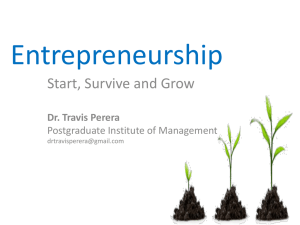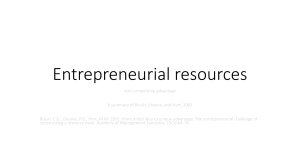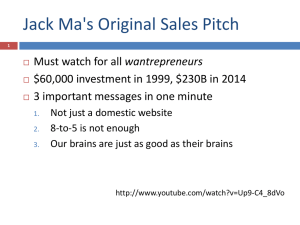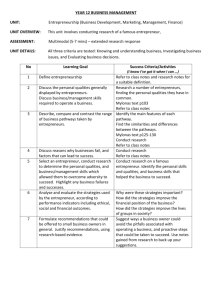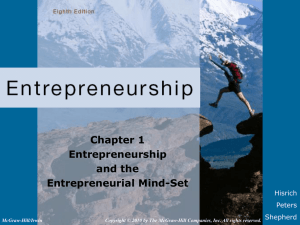Entrepreneurial Behaviors and Attitudes
advertisement
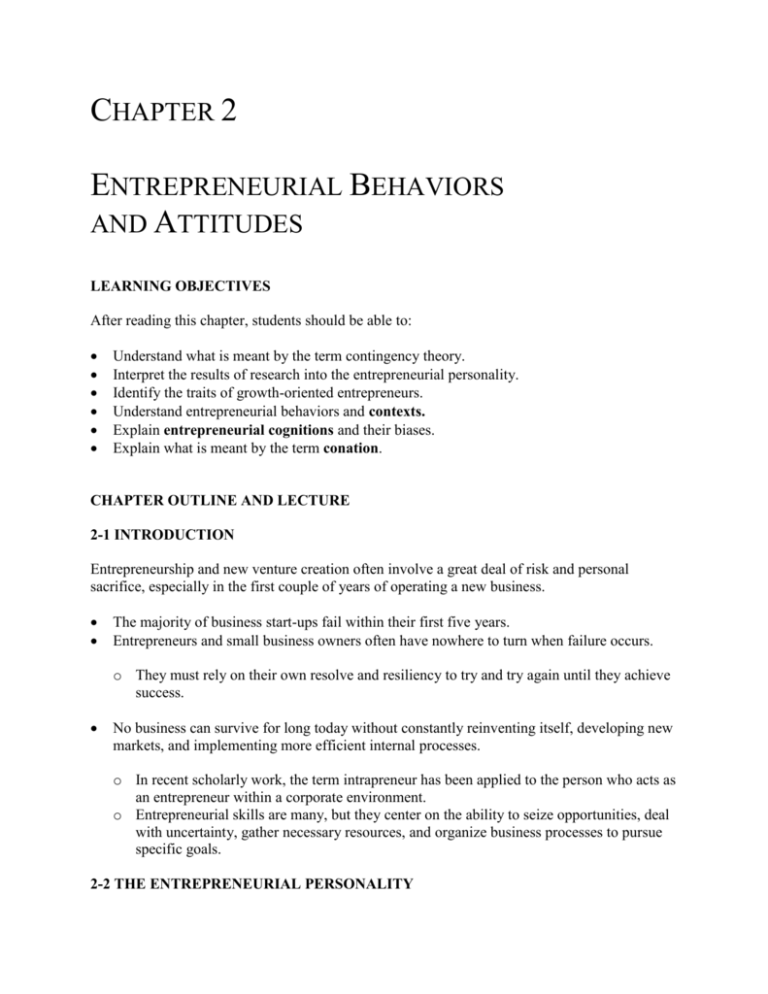
CHAPTER 2 ENTREPRENEURIAL BEHAVIORS AND ATTITUDES LEARNING OBJECTIVES After reading this chapter, students should be able to: Understand what is meant by the term contingency theory. Interpret the results of research into the entrepreneurial personality. Identify the traits of growth-oriented entrepreneurs. Understand entrepreneurial behaviors and contexts. Explain entrepreneurial cognitions and their biases. Explain what is meant by the term conation. CHAPTER OUTLINE AND LECTURE 2-1 INTRODUCTION Entrepreneurship and new venture creation often involve a great deal of risk and personal sacrifice, especially in the first couple of years of operating a new business. The majority of business start-ups fail within their first five years. Entrepreneurs and small business owners often have nowhere to turn when failure occurs. o They must rely on their own resolve and resiliency to try and try again until they achieve success. No business can survive for long today without constantly reinventing itself, developing new markets, and implementing more efficient internal processes. o In recent scholarly work, the term intrapreneur has been applied to the person who acts as an entrepreneur within a corporate environment. o Entrepreneurial skills are many, but they center on the ability to seize opportunities, deal with uncertainty, gather necessary resources, and organize business processes to pursue specific goals. 2-2 THE ENTREPRENEURIAL PERSONALITY Chapter 2: Entrepreneurial Behaviors and Attitudes 2-2 Years of scholarship to identify the essential ingredients of an effective entrepreneurial personality have yielded little agreement. Despite the lack of agreement on the essential personality traits of successful entrepreneurs, some characteristics of entrepreneurs and entrepreneurship are consistently portrayed and cited as important elements of entrepreneurial success. o Individuals who elect to become entrepreneurs rather than enter into a corporate career path either have, or develop skills that help them in launching and growing businesses. 2-2a The Individual Entrepreneur The entrepreneur, according to French economist J. B. Say, “is a person who shifts economic resources out of an area of lower and into an area of higher productivity and yield.” But Say’s definition does not tell us who this entrepreneur is. The commonplace definition of the entrepreneur is a person who starts his or her own new and small business. o Steve Case is an example of an entrepreneur because he founded and established America Online (AOL). Entrepreneurs serve customers in new ways, enter underserved markets, and exploit opportunities that others have missed; this is what entrepreneurship means. o Research into the personality of entrepreneurs continues, but the focus now is on what traits are useful in which contexts. The research has become more refined, reflecting the belief that there is not a single entrepreneurial “type” but that different behaviors, thoughts, and attitudes are more or less effective depending on the entrepreneurial context. Context is defined simply as the environment in which entrepreneurs find themselves. Context includes such aspects as 1. 2. 3. 4. The economic climate, Availability of capital, Support networks, and Technological resources. Management research in general has followed a path similar to the one being traversed by scholarly research into entrepreneurship. Chapter 2: Entrepreneurial Behaviors and Attitudes 2-3 o Early management theorists attempted to identify the managerial behaviors, cognitions, and attitudes that lead to success in all times and places. o That approach proved fruitless after years of effort and has given way to modern “contingency” theories of management. o Contingency theories of management assert that different behaviors, cognitions, and attitudes are effective in different contexts. 2-2b Anyone can become a successful entrepreneur: there is no single personality “type”that is defined as an “entrepreneurial type.” Yet, some ways of behaving and thinking are more effective than others for success in entrepreneurial careers. Entrepreneurial Behaviors Entrepreneurs exhibit many different personality types; searching for a specific personality pattern is very difficult. There are probably as many personality varieties among entrepreneurs as there are entrepreneurs. Researcher David McClelland, a noted social psychologist, determined that founders of highgrowth companies appear to share a distinct cluster of personal characteristics. High Need for Achievement: Growth-oriented entrepreneurs have a high need for achievement. o They need to succeed, to achieve, and to accomplish challenging tasks. o The strong desire for achievement leads to a desire for independence. o The need for achievement may help explain why growth-oriented entrepreneurs are not satisfied with founding or working in one firm; they need to prove themselves again and again. Low Need to Conform: Growth-oriented entrepreneurs listen, but they are able to ignore others’ advice. Also, handling skeptics is easy for entrepreneurs. o Taking the unpopular course of action, if they consider it best, is the way they do business. Persistence: Growth-oriented entrepreneurs are focused and persistent, doggedly doing what is best for the business to succeed. They work hard on the details and relentlessly attempt to find ways to become more profitable. High Energy Level: The capacity for sustained effort requires a high energy level. o The necessary work, planning, organizing, directing, creating strategy, and finding funds, can only be accomplished on a demanding schedule. Chapter 2: Entrepreneurial Behaviors and Attitudes 2-4 o The sixty-hour to eighty-hour workweek is common to entrepreneurs who have the drive to succeed no matter what it takes from a physical stamina perspective. Risk-Taking Tendency: McClelland’s findings suggest that people with a high need for achievement tend to take risks. o Growth-oriented entrepreneurs believe so strongly in their ability to achieve that they do not see much possibility of failure. Thus they accept risk and find it motivating. o These five personal characteristics identified by McClelland can be further condensed into four fundamental behaviors that all successful entrepreneurs exhibit: Across the different types of personality, researchers have found that entrepreneurs have an optimistic way of thinking that leads them to deal with failure and change differently than pessimists—they have a deep belief in the correctness of their cause. 1. Whereas pessimists view failure as personal and long lasting, optimists view failure as short-lived and due to causes beyond their control. 2. The optimists see failure as an opportunity to grow, whereas the pessimists see failure as a reflection of their own shortcomings. Commitment is necessary for success in entrepreneurship because of the length of time and amount of energy required to make a business successful. 1. Often, a new venture struggles for years while the entrepreneur attempts to find the right combination of product, price, and service to attract customers. 2. During these lean years, many new ventures fail because the entrepreneur/founder simply gives up. 3. Second wave of entrepreneurs who follow the pioneers into the market are able to succeed by learning from the pioneers’ mistakes. Focus is the term used to describe a singleness of purpose that is necessary during the early stages of a new venture. 1. Branson and Trump both made their fortunes in narrowly defined niches before branching into other business opportunities. 2. Successful entrepreneurs have intense focus on their core business in the early stages of their ventures. Later, when they have capital to spare, they can dabble in other ventures and test their skills in new industries. Drive is the intangible element of personality that is expressed as high energy and the ability to work long hours. 1. The drive to succeed is usually an internal motivation—some people are just more driven than others. Chapter 2: Entrepreneurial Behaviors and Attitudes 2-5 2. Many entrepreneurs help develop their own drive by creating a clear vision of where they would like to go and then using every resource at their disposal to achieve that vision. Another important factor to entrepreneurial success is the ability to work with others to achieve goals. o Successful entrepreneurs develop widespread social networks that they can leverage in time of need. 2-2c The Entrepreneur’s Social Network Researchers have begun to assess the importance of the entrepreneur’s social network as a means to gain support, knowledge, and access to distribution channels. Research has shown that an entrepreneur’s social network varies from time to time depending on the different phases of the venture’s life. Phases of venture development from this perspective are: o Phase 1: The Motivation Phase. Entrepreneurs discuss the initial idea and develop the business concept. o Phase 2: The Planning Phase. Entrepreneurs seek the knowledge and resources needed to launch the venture. o Phase 3: The Establishment Phase. Entrepreneurs actually establish and run the venture. Entrepreneurs need capital, skills, knowledge, and labor to start new ventures. o The entrepreneur provides some of these resources, and some are gathered from the entrepreneur’s social network. The networks of contacts that help bring about success are the entrepreneur’s social capital. o An entrepreneur’s social network has several characteristics. One of these is size. Entrepreneurs can enlarge their social networks to gain access to crucial resources. Another characteristic of a social network is positioning. Entrepreneurs can position themselves within the social network so as to shorten the path to crucial resources. Finally, some of the entrepreneur’s social relationships are single stranded, the relationship plays only one role in the network. Other relationships play multiple roles in the network, these are known as multiplex ties. Chapter 2: Entrepreneurial Behaviors and Attitudes 2-6 o Over time, entrepreneurs accumulate social capital, which is essential for starting new ventures. Research has demonstrated significant differences in social network size between phases 1 and 2. Successful entrepreneurs have developed larger social networks in phase 2 over phase 1, and more multiplex ties also characterize the phase 2 networks. However, the research found little difference in network size between phases 2 and 3. The number of years of experience for the entrepreneur did not affect the size of the social network. However, there is a significant gender difference: female entrepreneurs tend to have larger social networks than do male entrepreneurs. In terms of the amount of time spent developing social networks, entrepreneurs spend the least time during phase 1, with phase 2 entrepreneurs spending the most time developing their network. Phase 3 entrepreneurs spend an amount of time somewhere between phases 1 and 2. The research noted that entrepreneurs spend the most time on social network maintenance during phases 2 and 3. Entrepreneurs use their social capital differentially throughout the phases of venture development. In general, entrepreneurs limit their network during phase 1 while they explore the feasibility of the business idea. In phases 2 and 3, the social network is widened to gather the necessary resources for a successful venture. 2-3 ENTREPRENEURIAL COGNITIONS Researchers’ logic is that successful entrepreneurs routinely exhibit a range of cognitive skills that, if followed and practiced by others, will lead to their success as well. Scholars of entrepreneurship have recently begun the process of analyzing the thought processes of successful entrepreneurs. o A currently fruitful line of research into what makes entrepreneurs successful examines them from a cognitive perspective. In other words, this research examines how entrepreneurs think and how they process information as a prelude to action. Cognition and cognitive psychology are concerned with the study of individual memory, perception, thinking, and information processing. o In general, the study of cognition is the study of the processes by which sensory input is transformed, including how it is elaborated, stored, retrieved, and used. Chapter 2: Entrepreneurial Behaviors and Attitudes 2-7 Entrepreneurial cognitions have been defined as “the knowledge structures that people use to make assessments, judgments, or decisions involving opportunity, evaluation, venture creation, and growth.” o The study of entrepreneurial cognitions is about how entrepreneurs use mental models to simplify and piece together previously unconnected information that helps them identify and invent new products and services and to assemble the necessary resources to launch new ventures. o Using the cognitive approach, entrepreneurship researchers have made great strides toward explaining why some people become entrepreneurs and others do not. Entrepreneurs display distinct cognitive biases in decision environments characterized by uncertainty and complexity. o Yet, it is often these biases that enable entrepreneurs to take action despite incomplete information. In general, entrepreneurial research has found a variety of cognitive tendencies among entrepreneurs at the opportunity evaluation phase of a new venture. These tendencies include: o Overconfidence: This bias refers to the inability to recognize the limits of one’s personal knowledge. This bias stems from entrepreneurs’ relative ease of recalling their reasons for confidence in a new venture despite the existence of new information. This bias also influences entrepreneurs to seek information supporting their original opportunity evaluation rather than to seek potentially disconfirming information. o Belief in the Law of Small Numbers: Entrepreneurs tend to draw firm conclusions from a limited sample. They believe that the small sample from which they have derived their conclusions is representative of the greater population. Belief in the law of small numbers coupled with mostly positive information likely produces an overoptimistic view of the new venture’s prospects. o Planning Fallacy: Entrepreneurs tend to have a future orientation. Their tendency to ignore past information and treat the current situation as isolated and unique is known as the planning fallacy. Forecasts of future business outcomes are often based more on optimistic forecasts and scenarios rather than on hard evidence from the past. This orientation to the future and neglect of possibly countervailing past results also biases the entrepreneur to an overly optimistic view of the new venture. Chapter 2: Entrepreneurial Behaviors and Attitudes 2-8 o The Illusion of Control: An illusion of control occurs when an individual overemphasizes the extent to which personal skill can improve performance in situations in which chance plays a major role. People with this bias have a higher expectation of personal success than is warranted by reality. This bias may play a role in decisions such as making acquisitions or producing innovative new products or services. The active search process may produce this illusion because the entrepreneur generates confidence by virtue of the activity. A particular danger of this bias is underestimating competitive response. o Reasoning by Analogy: In an effort to understand a new situation, individuals often compare it to a more familiar one. The use of personal information may lead entrepreneurs to this bias, known as reasoning by analogy. Personal communications are usually more vivid and more easily recalled than are secondary resources and are likely to be used more readily in entrepreneurial judgments. The danger is that entrepreneurs may use this vivid information to the exclusion of potentially more salient information in decision-making. This bias can be dangerous in that firms may falsely believe that the operational needs of their analogy apply to the new venture. Thus, this bias can lead to a misjudgment of the need for complementary assets to achieve business goals. Scholarly research found these cognitive tendencies in a sample of entrepreneurs from smallto medium-sized enterprises (SMEs). However, the investigators learned that only the belief in the law of small numbers and the illusion of control seemed to affect opportunity evaluation. The practical remedy to these biases is for entrepreneurs to conduct systematic research on their new venture, including searching for information that runs counter to their optimistic evaluation. The following list contains a few approaches that entrepreneurs can use to minimize the risk that their business decisions are based on biased cognitions. o Active versus Passive Searching: Active searching is a process in which individuals intrude into the environment in an effort to understand it. In this type of search, individuals expend resources and cognitive effort in looking for answers. Chapter 2: Entrepreneurial Behaviors and Attitudes 2-9 In contrast, individuals receiving information passively receive it as it flows by. This “automatic” information search mode takes the environment for granted and allows individuals to direct attention elsewhere. In new ventures or new product launches, entrepreneurs need to take an active approach to their market environment. o Personal versus Impersonal Information: A major difference in the quality of information is based on whether it is obtained from personal or impersonal sources. Personal sources include direct contact with other individuals or the environment; impersonal sources involve written documentation such as magazine articles or reports generated by others. On the other hand, impersonal information can be vital for entrepreneurs to develop a balanced view of the new venture opportunity. Entrepreneurs with new ventures or new product launches tend to use the personal approach more than the impersonal one. o External versus Internal Sources: Entrepreneurs can also choose to use information generated internal to or external to the organization. Searching externally is usually a more active process because the external information is unlikely to be organized in the required manner. Thus, entrepreneurs using this technique are likely to expend more energy than are those using internal sources. Ventures that are pioneering new products or services require greater attention to external information sources than do established firms. Entrepreneurs develop a sense of self-efficacy by virtue of their market search, planning, and execution strategies. o This sense of efficacy leads to actions that bring new products and services into the market. Sensitizing entrepreneurs to the need to search both external and internal sources of information may mitigate the effects of bias. o Identifying specific information search processes and their potential biases is an important step in minimizing their potentially harmful effects. o Gaining insight into potential biases and misperceptions may lead to more effective action. 2-4 ENTREPRENEURIAL ATTITUDES Chapter 2: Entrepreneurial Behaviors and Attitudes 2-10 Conation refers to the connection of knowledge and affect to behavior and is associated with the issue of “why.” It is the personal, intentional, deliberate, goal-oriented, or striving component of motivation, the proactive (as opposed to reactive or habitual) aspect of behavior. Conation is closely associated with the concept of volition, defined as the use of will or the freedom to make choices about what to do. o Conation is absolutely critical if an individual is successfully engaged in self-direction and self-regulation. Some of the conative issues that an individual faces daily are: What are my intentions and goals? What am I going to do? What are my plans and commitments? o Some scholars have proposed that conation is necessary to explain how knowledge and emotion are translated into behavior in human beings. Conation has also been referred to as emotional intelligence, or EI. EI is a measure of people’s ability to understand and use their emotions to solve life’s problems. EI is similar to the more familiar measure of intelligence known as IQ. o Daniel Goleman and his colleagues have done extensive research into the effects of emotions on leadership behavior. In particular, they have examined the extent to which people’s knowledge of their own and others’ emotions enable them to be more effective managers and leaders. Goleman suggests that a person’s emotional abilities may be at least partially genetically determined. He states that a person’s emotional skills are not “genetically hardwired” like eye color or skin tone but that they do have a “genetic component.” Goleman presents a five-step program for people—of all ages—to improve their emotional skills. The five steps are: 1. 2. 3. 4. 5. Decide who you want to be. Determine who you are now. Develop a path from where you are to where you want to be. Determine how to make changes permanent. Find out who can help you get where you want to go. o Some research suggests that human beings have an emotional style or a preferred method of putting thought into action or interacting with the environment. Kathy Kolbe identifies four action, or conative, modes: 1. Fact Finder: Tendency to probe, refine, and simplify 2. Follow Through: Tendency to organize, reform, and adapt 3. Quick Start: Tendency to improvise, revise, and stabilize Chapter 2: Entrepreneurial Behaviors and Attitudes 2-11 4. Implementer: Tendency to construct, renovate, and envision In Kolbe’s formulation, the combination of the striving tendency, reason, and targeted goals results in different levels of commitment and action. At least five separate aspects of the direction subcomponent of conation are identified in the research: 1. 2. 3. 4. 5. Becoming aware of human needs Visions and dreams of possibilities Making choices Setting goals Making plans One of the first aspects of successful self-direction is for people to become aware of their human needs. o Maslow’s hierarchy of needs, developed by social psychologist Abraham Maslow, is probably one of the most well-known approaches, although research has suggested other human needs, such as the need for optimal arousal, the need for achievement, the need for cognitive balance, the need to find meaning in life, the need for power, and the need for social affiliation. A second aspect of conation is awareness of the possible self. The possible self provides the bridge to action; if people do not consider something to be possible. o They will not set goals and make plans. Long-term, vague statements represented by dreams and visions must be turned into goals. o If they are to impact immediate behavior. Additionally, dreams and goals must have visual and emotional components in order to be effective. A third aspect is the exercise of volition, or people’s freedom to choose and control their thoughts and behavior. Volition has two subcomponents: o Covert: Referring to the controlling of a person’s own actions o Overt: Referring to the controlling of the environment that impacts a person’s actions o A variety of researchers believe that volition ought to be the cornerstone of the psychological study of human behavior. o Their rationale is that whereas animals are controlled mainly by instincts and reflexes, human beings are not as controlled by these processes. o Learning and choice replace these biological processes, allowing human beings to think about and choose their behaviors. A fourth aspect of the direction component of conation is the setting of goals for the directions that have been chosen. Scholars have identified three types of goals: Chapter 2: Entrepreneurial Behaviors and Attitudes 2-12 o Mastery goals focus on the development of competence or on the process of learning. o Performance goals focus on the outcome or on winning or attaining credentials. o Social goals focus on the performance of the group or on the individual fitting in with others. People need to consider several important issues when they set goals. 1. First, goals must be difficult but attainable. According to the Yerkes-Dodson law, moderate amounts of difficulty lead to optimal performance. 2. Second, the emotional state of an individual can influence the goals that are set. Higher goals are set when the individual is emotionally aroused, and lower goals are set when the individual is depressed. 3. Finally, individuals with increased levels of self-efficacy set higher goals. When those goals are met, the individuals experience even higher levels of self-efficacy. A fifth aspect of successful self-direction is the development of plans that can turn visions and goals into reality. Plans must be written and specific, starting with a clear description of desired outcomes. Two processes can be employed: backwards planning and task analysis. o To be successful, backwards planning must be accompanied by a task analysis that will identify the skills and knowledge required to learn or perform a specific task. o By systematically completing a task analysis while working backward from the desired end results, the individual arrives at the starting point with a clearly delineated plan for obtaining those goals. o Entrepreneurial attitudes can be cultivated over time, but each person has certain innate tendencies or predispositions toward each of the attitudes we have discussed. o The entrepreneur must learn not to fight against natural tendencies but rather to recognize them and to compensate for them wherever possible. o Successful entrepreneurs leverage their strengths and find ways to compensate for their weaknesses. Chapter 2: Entrepreneurial Behaviors and Attitudes 2-13 KEY TERMS Backwards planning: A development step in which planners start with their desired end result and then identify their most immediate state and the required procedures to meet the desired result. Cognition and cognitive psychology: Areas of study that are concerned with individual memory, perception, thinking, and information processing. Cognitive biases: Perceptive tendencies among entrepreneurs that enable them to make complex decisions despite incomplete information. Examples include overconfidence and the illusion of control. Conation: The connection of knowledge and affect to behavior; associated with the issue of “why.” Context: The environment in which entrepreneurs find themselves. Contingency theories of management: Management theories that assert that different behaviors, cognitions, and attitudes are effective in different contexts. Emotional intelligence: A measure of people’s ability to understand and use their emotions to solve life’s problems. Entrepreneurial cognitions: The knowledge structures that people use to make assessments, judgments, or decisions involving opportunity, evaluation, venture creation, and growth. Maslow’s hierarchy of needs: A theory that human needs can be divided into five basic categories: physiological, safety, social, esteem, and self-actualization. Multiplex ties: Relationships within an entrepreneur’s social network that play multiple roles. Personal characteristics: A pattern or cluster of traits. Personality types: Descriptive behavioral characteristics, such as introverted, analytical, brash, and emotional. Positioning: Method used by entrepreneurs within their social networks to shorten their path to crucial resources. Possible self: That aspect of conation that allows entrepreneurs to visualize their goals and dreams so that they can act on them. Single stranded: A relationship that plays only one role in an entrepreneur’s social network. Chapter 2: Entrepreneurial Behaviors and Attitudes 2-14 Social capital: An entrepreneur’s networks of contacts that help the entrepreneur become successful. Social network: The social environment in which entrepreneurs build their ventures by gaining support, knowledge, and access to distribution channels. Task analysis: A development step in which planners identify the skills and knowledge required to learn or perform a specific task. Volition: The use of will or the freedom to make choices about what to do. Yerkes-Dodson law: Maxim that states that moderate amounts of difficulty lead to optimal performance. Chapter 2: Entrepreneurial Behaviors and Attitudes 2-15 PRACTICE QUIZ 1. The term intrapreneur has been applied to the person who acts as an entrepreneur within a corporate environment. Answer: True Reference: 2-1 2. Growth-oriented entrepreneurs have a high need for achievement: they need to succeed, to achieve, and to accomplish challenging tasks. Answer: True Reference: 2-2b 3. Growth-oriented entrepreneurs listen, but they are able to ignore others' advice. Answer: True Reference: 2-2b 4. Successful entrepreneurs have intense focus on their core business in the early stages of their ventures. Answer: True Reference: 2-2b 5. The important factor to entrepreneurial success is working with others to achieve goals. Answer: True Reference: 2-2b 6. During the planning phase, entrepreneurs seek the knowledge and resources they need to launch their venture. Answer: True Reference: 2-2c 7. Drive is the intangible element of personality that is expressed as low energy and the ability to work long hours. Answer: False Rationale: Drive is the intangible element of personality that is expressed as high energy and the ability to work long hours. Reference: 2-2b 8. Higher goals are set when the individual is emotionally aroused, and lower goals are set when the individual is depressed. Answer: True Reference: 2-4 9. “Making choices” is not one of the aspects of the direction subcomponent of conation. Answer: False Rationale: Research identifies at least five separate aspects of the direction subcomponent of conation, one of which is “making choices.” Reference: 2-4 10. People must consider several important issues when setting goals. First, their goals must be easy but attainable. Answer: False Chapter 2: Entrepreneurial Behaviors and Attitudes 2-16 Rationale: Goals must be difficult but attainable. Goals that are perceived as too easy do not increase behavior. Reference: 2-4 11. Kolbe’s action, or conative mode, of follow through is identified as a a. Tendency to probe, refine, and simplify. b. Tendency to organize, reform, and adapt. c. Tendency to improvise, revise, and stabilize. d. Tendency to construct, renovate, and envision. Answer: B Rationale: In Kolbe’s formulation of people’s emotional styles, she describes the action of follow through as the tendency to organize, reform, and adapt. Reference: 2-4 12. Entrepreneurs at the opportunity evaluation phase of a new venture exhibit a number of distinct cognitive biases. These tendencies include: a. Overconfidence b. Belief in the law of small numbers c. The illusion of control d. All of the above Answer: D Rationale: According to entrepreneurial research, the cognitive tendencies engaged in by entrepreneurs are overconfidence, belief in the law of small numbers, the illusion of control, planning fallacy, and reasoning by analogy. Reference: 2-3 13. The areas of cognition and cognitive psychology focus on a. Individual memory. b. Perception. c. Thinking. d. All of the above. Answer: D Rationale: The study of cognition and cognitive psychology addresses the issues of individual memory, perception, thinking, and information processing. Reference: 2-3 14. Which of the following is a fundamental behavior exhibited by all successful entrepreneurs? a. Keep a short turnaround time. b. Have passion. c. Be focused. d. Keep the customer happy. Answer: C Chapter 2: Entrepreneurial Behaviors and Attitudes 2-17 Rationale: The four fundamental behaviors that all successful entrepreneurs exhibit are belief, commitment, focus, and drive. Reference: 2-2b 15. Which of the following terms describes the ability of entrepreneurs to deal with failure and continue beyond it without dwelling a long time on how it happened? a. Hard work ethic b. Drive c. Focus d. Resilience Answer: D Rationale: Entrepreneurs who have developed the conative skill of resilience are able to meet failure and continue on past it without undue time spent reviewing the causes of the failure. Reference: Summary Chapter 2: Entrepreneurial Behaviors and Attitudes 2-18 QUESTIONS TO BE DISCUSSED 1. What is entrepreneurship? How does entrepreneurship help a nation’s economy? Suggested approach: The entrepreneur, according to French economist J. B. Say, “is a person who shifts economic resources out of an area of lower and into an area of higher productivity and yield.” But Say’s definition does not tell us who this entrepreneur is. The commonplace definition of the entrepreneur is a person who starts his or her own new and small business. As a manager working within an organization, you will also need entrepreneurial skills to help your division and your company succeeds. No business can survive for long today without constantly reinventing itself, developing new markets, and implementing more efficient internal processes. In recent scholarly work, the term intrapreneur has been applied to the person who acts as an entrepreneur within a corporate environment. Students must identify how entrepreneurship helps a nation’s economy. As stated above, entrepreneurship helps the economy by shifting resources into higher productivity areas, hence bolstering a nation’s economy by making better use of its resources. REF: 2-1, 2-2a 2. Name an entrepreneur whom you know personally. Describe that person. Did that person learn to become an entrepreneur, or is that person an entrepreneur “by nature”? Suggested approach: The entrepreneur, according to French economist J. B. Say, “is a person who shifts economic resources out of an area of lower and into an area of higher productivity and yield.” The students should provide details of any entrepreneur they know personally, describe the individual, and determine that individual’s path to becoming an entrepreneur. The students have to identify if the individual learned to become an entrepreneur or whether he or she is an entrepreneur by nature. REF: 2-1 3. Describe the personality of the growth-oriented entrepreneur as defined by McClelland? Answer: McClelland’s findings suggest that people with a high need for achievement tend to take risks. Growth-oriented entrepreneurs believe so strongly in their ability to achieve that they do not see much possibility of failure. Thus they accept risk and find it motivating. These five personal characteristics identified by McClelland can be further condensed into four fundamental behaviors that all successful entrepreneurs exhibit: Belief Chapter 2: Entrepreneurial Behaviors and Attitudes 2-19 Commitment Focus Drive REF: 2-2b 4. What is meant by the term illusion of control? How does that cognitive bias affect the entrepreneur? Answer: The Illusion of Control. An illusion of control occurs when an individual overemphasizes the extent to which personal skill can improve performance in situations in which chance plays a major role. People with this bias have a higher expectation of personal success than is warranted by reality. This bias may play a role in decisions such as making acquisitions or producing innovative new products or services. The active search process may produce this illusion because the entrepreneur generates confidence by virtue of the activity. A particular danger of this bias is underestimating competitive response. REF: 2-3 5. What is the value of active versus passive search? Why should an entrepreneur avoid using only personal sources for information regarding a new venture or new product launch? Answer: Active searching is a process in which individuals intrude into the environment in an effort to understand it. In this type of search, individuals expend resources and cognitive effort in looking for answers. In contrast, individuals receiving information passively receive it as it flows by. This “automatic” information search mode takes the environment for granted and allows individuals to direct attention elsewhere. In new ventures or new product launches, entrepreneurs need to take an active approach to their market environment. A major difference in the quality of information is based on whether it is obtained from personal or impersonal sources. Personal sources include direct contact with other individuals or the environment Impersonal sources involve written documentation such as magazine articles or reports generated by others. Entrepreneurs with new ventures or new product launches tend to use the personal approach more than the impersonal one however it is important for the entrepreneur to use impersonal source as such information can be vital for entrepreneurs to develop a balanced view of the new venture opportunity. REF: 2-3 Chapter 2: Entrepreneurial Behaviors and Attitudes 2-20 6. Do you believe you have the free will to choose to become what you want in life? Explain. If you believe you have free will, are you making choices that are in your best interest? Why or why not? If you believe you don’t have free will, what can you do to improve yourself? Suggested approach: The student should provide their individual opinion on: Whether they think that they are free to choose to become what they want in their life: o If yes, do they think they are making the choices that serve best their individual interest—why do they think so or why don’t they think so. o If no, what do they think they could do to improve themselves? 7. Explain what is meant by the term resilience. Why do you think resilience is important to the entrepreneur? Answer: To be successful, entrepreneurs must develop the conative skill of resilience. Resilience is simply the ability to meet failure and to continue on past it without undue time spent reviewing the causes of the failure. Although entrepreneurs need to learn from their actions and to find ways to minimize the risk of repeating mistakes and failures, they are future focused. Entrepreneurs typically don’t spend time feeling guilty about or unnecessarily flogging themselves for failure. The final essential skill of entrepreneurship is to move forward. Entrepreneurs must move quickly to keep on top of the competition and to be successful. Therefore, resilience is needed to help them move past obstacles to focus on future challenges, rather than being distracted by past events. REF: Chapter summary 8. Are you aware of your possible self? What steps can you take to become more aware of your possible self? Suggested approach: The possible self provides the bridge to action; if people do not consider something to be possible. The student needs to follow up with a few self-assessment tests and ascertain the steps that he or she should take to become aware of him- or her-self. REF: 2-4 9. Why do you think most new ventures fail within their first five years? Answer: Entrepreneurship and new venture creation often involve a great deal of risk and personal sacrifice, especially in the first couple of years of operating a new business. The majority of business start-ups fail within their first five years. Entrepreneurs and small business owners often have nowhere to turn when failure occurs. The reasons for failure Chapter 2: Entrepreneurial Behaviors and Attitudes 2-21 maybe several, for one no business can survive for long today without constantly reinventing itself, developing new markets, and implementing more efficient internal processes. In recent scholarly work, the term intrapreneur has been applied to the person who acts as an entrepreneur within a corporate environment. Entrepreneurial skills are many, but they center on the ability to seize opportunities, deal with uncertainty, gather necessary resources, and organize business processes to pursue specific goals. One of the other reasons why failure may take place could be because of commitment, which is necessary for success in entrepreneurship because of the length of time and amount of energy required to make a business successful. Often, a new venture struggles for years while the entrepreneur attempts to find the right combination of product, price, and service to attract customers. During these lean years, many new ventures fail because the entrepreneur/founder simply gives up. REF: Introduction, 2-2b 10. Will you become an entrepreneur someday? Why or why not? Suggested approach: The students should provide their opinion in whether they would want to become an entrepreneur someday. Chapter 2: Entrepreneurial Behaviors and Attitudes 2-22 RUNNING CASE: COMMUTER COFFEE “Refining the idea” Running Case: Commuter Coffee Introduction: The CEO, Carlos, called the meeting to order. He asked if anyone had spent time thinking about the coffee company idea since their last meeting. Everyone spoke at once. All had been thinking about it and had definite ideas of what it should be and how it should be done. Questions for Discussion 1. What do you think of the Commuter Coffee business concept that the group agreed to pursue? Explain your response. Suggested approach: The students should ascertain and analyze a few details about the commuter coffee business such as: Is the name of the coffee shop good and catchy enough. Would a coffee business be more profitable if it is in varieties or does location also matter? Based on this the students should provide their opinion on the concept that the ground agreed to purse, in detail. 2. What research assignments and other tasks did the group assign after it agreed on the business concept? Do you think that the assigned tasks will help them learn more about the potential for the business? What have they missed? Suggested approach: In the above case, Jessie was assigned the job of investigating possible locations. Shena agreed to research the traffic counts on city streets at the commuter period of the morning. Carlos and Tina agreed to establish a plan for how the customers have to take precedence. Students should provide their opinion on whether the assigned tasks will help them learn more about the potential for the business and whether the group has missed out on any important step. 3. This new venture is being launched by a group of people who decided they wanted to work together. Do you think this approach is effective for new venture creation? What is the importance of interpersonal relationships to the potential success of a new venture? Suggested approach: Students need to offer their opinion on whether they consider interpersonal relationships an important approach to create an effective new venture. Chapter 2: Entrepreneurial Behaviors and Attitudes 2-23 EXPERIENTIAL EXERCISE 1 “Assess Your Entrepreneurial Personality” Introduction: Starting an entrepreneurial venture usually carries substantial risk of failure. People who launch entrepreneurial ventures must be prepared to handle the personal impact of risk and have an ability to deal with occasional failure. Of course, the goal of entrepreneurship is to minimize risk and to achieve success. Still, most entrepreneurs will readily admit that the road to success contains difficulties and that anyone who aspires to an entrepreneurial lifestyle must have personal resources to deal with adversity. Suggested approach: Since entrepreneurs can’t eliminate risks, they work to minimize them. This approach helps speed the activities of entrepreneurs while allowing them to work in an environment that has minimized risk. Based on the information provided in the website mentioned below, the student needs to analyze and provide solutions to the question below. http://www.gsu.edu/~wwwsbp/entrepre.htm 1. What does it mean to say that entrepreneurs are “risk minimizers”? 2. How can a person who currently is not risk tolerant learn to become more risk tolerant over time? 3. What are some techniques you use to manage risk in your life? How do these techniques relate to your potential to become a successful entrepreneur? Chapter 2: Entrepreneurial Behaviors and Attitudes 2-24 EXPERIENTIAL EXERCISE 2 “A Conversation with an Entrepreneur” Introduction: Entrepreneurs are not hard to find—nearly every store and shop in your neighborhood was founded by an entrepreneur (unless it is a chain store). Suggested approach: The students should identify and contact an entrepreneur in their community for a brief conversation. Based on the conversation they should provide solutions for the below mentioned questions: 1. 2. 3. 4. 5. 6. How many ventures has the entrepreneur been involved with as an owner? When did this person first realize that he or she wanted to be an entrepreneur? Why did this person choose to be in the business he or she is in? What support has the entrepreneur had along the way? Has the entrepreneur used a business plan to guide the business’s growth? What mistakes has the entrepreneur made, and how did he or she overcome those mistakes? Besides answering the above questions students should also write a brief (one- to two-page) essay about their conversation with an entrepreneur and what lessons they were able to learn. Chapter 2: Entrepreneurial Behaviors and Attitudes 2-25 OTHER RESOURCES Websites of interest: History of the H. J. Heinz Company http://www.heinz.com/jsp/history.jsp The Consortium for Research on Emotional Intelligence in Organizations This website provides links to research articles on emotional intelligence in the workplace. http://www.eiconsortium.org/

